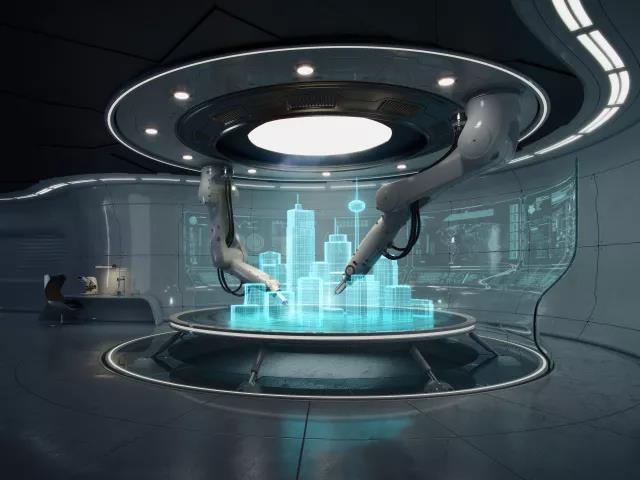人工智能(Artificial Intelligence),英文缩写为AI。它是研究和开发用于模拟、延伸和扩展人的智能的理论、方法、技术及应用系统的一门新的技术科学。

译文:
近年来,建筑中的技术和自动化飙升,正在跨越实践的各个方面,包括项目交付、性能、评估和计费。但并非所有建筑师都利用新兴技术,并且越来越多的人认为,如果企业没有将人工智能融入实践中,他们就会落后。
“我们长时间以来一直在讨论这些问题,” AIA2018 年建筑实践知识社区技术主席兼Jacobs的新兴技术主管Natasha Luthra说。“整个行业可能会在一瞬间改变我们,” 她在最近的建筑联盟大会上说,“在我们被革命打败之前我们必须找到一种方式领先于革命。”

建筑和软件公司正在比其他公司更快地融合人工智能,这可能会让设计师摆脱关于技术如何影响实践这一关键决策。AIA,美国伊利诺伊大学厄巴纳 - 香槟建筑学院研究生学院副主任Randy Deutsch撰写了三本关于专业实践中的设计技术的书。“我们很快就会看到超级智能进入几乎每个部门、市场和领域,”他说,“建筑师们有必要想象一下,它将进入我们的领域,现在我们有机会做一些事情,寻找能真正改善我们正在做的事情以及使我们从业者有利可图的方法,而不是成为让其他人接受它并与其一起前进的受害者。”

“人工智能可以取代人类,尤其是设计师,这是没有根据的。”——Patrick Hebron

Miller和Hebron一致认为,应由人类测定机器如何比过去帮助我们更智能地解决问题。“我们也可以将机器视视作为支持人类决策过程提供可能性或证据,” Hebron说。保险地说,设计决策最终将由人类作出—或者至少由人类验证—在可预见的将来。


从抽象转向可操作性一直是一项挑战。谈到AI,要先从数据说开始说。人工智能是数据的应用—数据是机器学习的东西—而且在AEC(Architecture,Engineering and Construction)世界里,不缺少获得它的机会。从计费分析和施工现场安全到建筑产品和性能,可用于收集的数据集似乎是无限的。

收藏仅仅是一个开始。存储和共享是数据公式的两个更大的部分。“我们一直在收集数据,但我们一直在用电子邮件、丰富的笔记和用户会议进行收集。以一种可以共享的格式拥有一直是个挑战。” Howard说道,他与dRofus的合作正在帮助建立一个在建筑师、承包商和业主之间共享数据的平台。

这个行业在通过建筑研究信息知识库(BRIK)进行研究和案例研习方面取得了进展,但在行业范围内共享大数据仍存在差距,大数据可用于在较大范围内自动化和改进设计和实践。通过云技术,数据存储和共享可能会变得更容易。“结合大量的数据和我们拥有的工具,我们也有云,为我们提供了即时反馈,”Deutsch说道,他认为反馈和共享是在设计过程中利用数据的关键。

不幸的是,数据存储、交付和共享方面的问题非常复杂—法规、安全和道德都起着作用—而且AEC中的数据还没有主要的法律标准。“某种程度上说,软件和云技术远远领先于政府政策还未赶上的曲线,”Miller说,“还有一些其他情况,政策的施行实际上会禁止常用的建筑产品进入市场使用,因为有更严格、严厉的标准可以用于数据。”
数据共享是一个多层次的概念,它可以发生在内部,也可以发生在外部。在公司内部的项目中共享数据可以带来更好的设计和项目交付。“当谈到建筑师可能掌握的东西,建筑信息是一个关键的数据源,”Miller说,“BIM经常被定位为生产工具,一种生成可交付成果的方式,但实际上这些是与公司特定知识库相关的丰富数据资源,可用于对一个系列或未来设计前景做出明智决策。”作为另一个例子,使用后评估数据可以很容易被用来为设计前期相似建筑类型的新项目提供信息。“这是任何公司都可以做的事情,” Deutsch说,“当你有权访问数据时—数量越多越好—这样会更容易。”每个项目都是为未来项目提供信息的机会。如果建筑师考虑到超出合同规定的义务,他们可以改善他们的建筑以及他们与合作者的关系。

“做一件事最令人信服的理由就是自身利益,而分享数据关系到每个人的自身利益。Hebron说,“没有谁不愿受益。”建筑公司应该寻求从业主、其他公司、承包商和软件公司那里获得数据—并分享他们自己的数据作为回报。这将创建一个行业范围的信息循环,可能重新定义实践方法并带来利润。“如果建筑师表现出希望帮助整个过程的诚意,即使他们不直接受益,我坚信,从商业角度看,他们将长期受益,” Deutsch说。
这确实是底线:将时间和资源投入到每个建筑师业务的数据和自动化中有长远的好处。带来新的工作方式的机会太大而无法忽视。大公司、中型企业和软件公司正在牵头。赞助Building Connections Congress的Luthra的公司Jacobs推出了Jacobs Connected Enterprise,这是一套用于数据集成和分析的数字工具。KieranTimberlake开发了用于评估建筑物整个生命周期的应用程序。Autodesk的BIM 360软件正在收集和分析大量施工数据,以提高安全性和合规性。像WeWork这样的大型破坏者也进入了这个空间—扮演业主、承包商和设计师—可以访问与他们财产相关的所有数据。这些只是AEC领域当前AI玩家的一小部分。

占据美国行业大多数的小公司如何在他们的工作中使用AI?这肯定会很棘手,根据Kilkelly的说法,他将航空指挥部作为一名个人执业者运营。“如果你是一家小公司,你没有太多时间专门研究这些话题,”他说,“你必须深入了解你的工作,然后密切关注其他公司和软件公司正在做什么以及外部有什么研究。然后思考如何将这些知识引入到你自己的工作中。
“你必须从小处着手,学会如何管理复杂性。” – AIA,Michael Kilkelly

实现自动化乏味任务的机会唾手可得,并且有许多简单的入门方法。Miller的公司最近推出了LunchBox,这是一套用于Grasshopper和Dynamo的免费计算设计工具,还包括机器学习组件。最大限度地利用这些插件工具—或者学习如何在Microsoft Excel中运行小脚本这样简单的操作—可以节省建筑师在日常操作中的时间和金钱。“总有一种理解,那就是有更好的方式去做某件事。”Kilkelly说,“看一下各个步骤,然后查看任务并找出一种自动的方法。让它更快,更轻松。当你开始构建这些自动化系统时,你可以将它们集中到一个更全面的自动化系统中。“
这些工具的集中将帮助建筑师开始理解大数据和人工智能的潜力,并在短期内提高他们的生产力。“一旦开始堆叠工具并将它们一起使用,它们就会变得更加强大,”Deutsch说道,“当你开始使用你可以获得的数据时,你可以更充分地利用这些工具,让你可以设计更多,或者如果你是一个企业主,可以让你去做更多的工作而不是在文件资料上花费你所有的时间。”他说。

人工智能很容易被视为与人类脱节。然而,在建筑学中,人的因素可能是最重要的。各种规模的公司都可以从投资合适的人才中受益,帮助他们接近面临实践的新时代。“在一个竞争激烈的市场上改进业务和新的技能,非常受截止时间限制......不会在日常工作中留下很多空间去注意这些事情,” Miller补充说,责任在于成功的实践,即考虑培训并鼓励员工在管理运营时学习新事物。

当你的团队中有合适的人时,两样都做是有可能的。在加利福尼亚的一家大公司工作时,Kilkelly希望有机会精简其部分设计流程。他发现,通过使用简单的自动化方法,他成了他公司的宝贵资产。通过分享他的技能,他为自己和众多其他员工节省了时间和精力。作为一名教育者,Deutsch首先相信人力资本。他对企业领导者负责:聘请和培养对探究工具有好奇心的新兴专业人士,给予他们信心和能力使用这些工具,并发挥他们作为数字原住民的优势进行组合和扩充。“在我们的职员和我们未来的职业中培养这些素质比学习工具和技能更重要。”他说。

原文:
In recent years technology and automation in architecture have soared, now spanning all aspects of practice including project delivery, performance, evaluation, and billings. But not all architects have taken advantage of emerging technologies, and there is a growing sense that if firms don’t incorporate artificial intelligence into practice, they’ll get left behind.
“We’ve been talking about these issues for a very long time,” said Natasha Luthra, AIA, 2018 chair of the Technology in Architectural Practice Knowledge Community and director of emerging technologies at Jacobs. “The entire industry could change on us on a dime,” she stated at the recent Building Connections Congress. “We have to find a way to get ahead of the revolution before we get flattened by it.”
Construction and software companies are incorporating AI more quickly than firms, which could leave architects out of key decisions in how the technology will influence practice. Randy Deutsch, AIA, associate director for graduate studies at the University of Illinois at Urbana-Champaign School of Architecture, has written three books on design technology in professional practice. “We're soon going to see super intelligence enter just about every sector, market, and field,” he says. “It would behoove architects to imagine that it’s going to enter our field, and we have the opportunity now to do something about it, to look at ways it can actually improve what we're doing and make us more profitable as practitioners as opposed to being victim to somebody else taking it and running with it.”
"It’s unfounded that AI can replace humans, especially as designers." - Patrick Hebron
Some fear that technology is advancing so quickly that the learning curve will be impossible for architects to overcome, or that artificial intelligence will replace architects altogether. According to experts, that is highly unlikely. “It’s unfounded that AI can replace humans, especially as designers,” says Patrick Hebron, a user experience designer with Adobe Systems and adjunct graduate professor at New York University. “AI has limited purview into the nature and proclivities of human experience,” he asserts, adding that the human element is crucial because leaving design to machines alone would create an unlivable built environment.
Architects should see artificial intelligence as an opportunity—a tool to augment practice, replacing mundane tasks—not as a threat to their jobs. As founder and CEO of digital design agency Proving Ground, Nate Miller researches and develops data-driven software for the building industry. “If you dig into the science behind artificial intelligence and research into machine learning, you may find highly futurist stuff,” he says. “But where it’s applied, it isn’t used as a replacement for human thinking or problem-solving. It’s meant to be an accelerator that positions the computer to handle certain things that a computer is really good at.”
Miller and Hebron agree that it falls on humans to determine how machines can help us solve problems more intelligently than in the past. “We could also think of the machine as offering possibilities or evidence to support the human decision-making process,” Hebron states. It’s safe to say that design decisions will be ultimately made by humans—or at least verified by humans—for the foreseeable future.
In a time when the value of architects and their services is being questioned, practitioners need to move from theoretical discussions about the future to incorporating data and automation into their everyday workflow. In doing so they'll create efficiencies to cut down on wasted time, ultimately enhancing practice models and adding value to the entire profession. Luckily, architects have the creative problem-solving abilities to do just that, but they will still have to actively shift their thinking. “We don’t often cast a critical eye at the way we’re getting our work done,” says Michael Kilkelly, AIA, principal of Space Command and owner of ArchSmarter, a company dedicated to making technology approachable for designers. “I think there is a lot of opportunity in the way we work to think creatively about how we could do it better,” he says.
What is AI?
Moving from the abstract to the actionable is always a challenge. When it comes to AI, it starts with data. Artificial intelligence is the application of data—data is what machines learn from—and in the AEC world there is no shortage of opportunities to obtain it. From billing analysis and construction-site safety to building products and performance, the data sets available to collect seem infinite.
For architects to rely on data and leverage it through artificial intelligence in the design process, a first step is to just start accumulating as much as possible. Brok Howard is an architect and technical account manager for dRofus, a planning, data management, and BIM collaboration software. “Any data that you can collect today that can help you tomorrow is the data you should be collecting,” he says. Howard believes that architects are in a prime position to use data to advance the profession.
Collection is just the beginning. Storage and sharing are two even bigger parts of the data equation. “We’ve always been collecting the data, but we’ve been doing it with emails, copious notes, and user meetings. Having it in a format that can be shared has always been the challenge,” says Howard, whose work with dRofus is helping to create a platform for sharing data amongst architects, contractors, and owners.
The industry has progressed in making research and case studies available through the Building Research Information Knowledgebase (BRIK), but there is a still a gap in industry-wide sharing of big data, which could be utilized to automate and improve design and practice on a larger scale. Data storing and sharing may become easier through cloud technology. “In combination with large quantities of data and the tools we have, we also have the cloud, which provides us with instantaneous feedback,” says Deutsch, who thinks feedback and sharing are key for leveraging data in the design process.
Unfortunately, problems with data storage, delivery and sharing are complex—regulations, security, and ethics all come into play—and there are no major legal standards for data in AEC yet. "In some ways, software and cloud technology are so far ahead of the curve that govenment policy hasn't quite caught up," Miller says. "And then there are other cases where policies are being introduced that would actually prohibit commonly used architectural products hitting the market from being used because there are stricter, more rigorous standards around what you can use with data.”
Data sharing is a multilayered concept, and it can occur internally as well as externally. Sharing within a firm, amongst projects, can influence better design and project delivery. “When it comes to what an architect may have at their disposal, building information is a critical data source,” says Miller. “BIM is often positioned as a production tool, a way to generate a deliverable, but these are actually data-rich resources tied to a firm’s particular knowledge base that can be used to make informed decisions about a portfolio or future design prospects.”
As another example, post-occupancy evaluation data can easily be used to inform the pre-design for new projects of similar building types. “This is something that any firm can do,” says Deutsch. “And when you have access to data—and the larger the quantity, the better—that will make it easier.” Every project is an opportunity to inform a future project. If architects look beyond what they are contractually obligated to do to, they can improve their buildings and their relationships with collaborators.
One of the most pervasive issues with architectural data is the protection of intellectual property. When firms are conducting research and development, they are often hesitant to share knowledge because architects are taught to keep their ideas and information away from competitors. However, sharing data could actually be more beneficial than keeping it close to the chest, as it would benefit the profession at large.
“The most compelling reason to do something is self-interest, and sharing data is in everyone’s self-interest,” says Hebron. “There’s no one at the table who doesn’t benefit.” Architecture firms should seek to acquire data from owners, other firms, contractors, and software companies—and share theirs in return. This would create an industry-wide information loop that may redefine practice methods and drive profits. “If the architect shows good faith that they want to help the whole process even if they don’t benefit directly, I believe strongly, from a business case, that they will benefit in the long term," Deutsch states.
And this is really the bottom line: There are long-term benefits to investing time and resources into data and automation for every architect's business. The opportunity to influence a new way to work is too big to ignore. Large firms, midsize firms, and software companies are leading the charge right now. Luthra's company, Jacobs, which sponsored the Building Connections Congress, has launched Jacobs Connected Enterprise, a suite of digital tools for data integration and analysis. KieranTimberlake has developed apps for assessing buildings throughout their lifecycle. Autodesk's BIM 360 software is collecting and analyzing massive amounts of construction data to improve safety and compliance. There are big disruptors like WeWork entering the space, too—acting as owner, contractor, and designer—with access to all the data associated with their properties. And these are just a few of the current AI players in AEC fields.
How can you use AI?
How can smaller firms, which make up the majority of the industry in the US, utilize AI in their work? It's definitely going to be tricky, according to Kilkelly, who operates Space Command as a sole practitioner. “If you’re a small firm, you don’t have a whole lot of time to dedicate to researching these topics,” he says. “You have to look inward at the way you’re working, and then keep an eye outward on what other firms and software companies are doing and what research is out there. Then, think about ways you can bring that knowledge into your own work.”
“You have to smart small and learn to manage the complexity.” - Michael Kilkelly, AIA
The learning curve can be pretty steep, but architects don't need to wait for technology to trickle down from larger firms to start implementing automation into their work. “It’s like baby steps,” Kilkelly says. “You can’t jump all the way into full AI and machine learning if you don’t really know what that means in terms of your own work. You have to smart small and learn to manage the complexity.”
Opportunities to automate mundane tasks are low-hanging fruit, and there are many simple ways to get started. Miller’s company recently launched LunchBox, a set of free computational design tools for Grasshopper and Dynamo, which also includes machine learning components. Maximizing such plug-in tools—or learning something as simple as how to run a small script in Microsoft Excel—can save an architect time and money in day-to-day operations. “There’s always an understanding that there’s got to be a better way to do something,” Kilkelly says. “Look at individual steps, then look at the tasks and figure out a way to automate. Make it faster, make it easier. As you start to build in those automations, you can cluster them together into a more comprehensive automation.”
That clustering of tools is what will really help architects start to understand the potential of big data and artificial intelligence and, in the short term, enhance their productivity. “The minute you start overlapping tools and using them together, they become much more powerful,” says Deutsch. “When you start tapping into the data you have available to you, you’re able to make higher uses of the tools, freeing you up to design more or, if you’re a business owner, to go after more work instead of spending all your time in documentation,” he says.
Artificial intelligence could easily be seen as divorced from humanity. In architecture, though, the human element is perhaps the most important one. Firms of all sizes can benefit from investing in the right talent to help them approach this new era facing practice. “Evolving a business and introducing new skills in a marketplace that is highly competitive, very deadline-driven…it doesn’t leave a lot of room in the day-to-day to pick up on these things,” says Miller, adding that the onus falls on successful practices to think about training and encouraging staff to learn new things while managing operations.
And it’s very possible to do both when you’ve got the right people on your team. While working at a large firm in California, Kilkelly looked for opportunities to streamline parts of his design process. He found that by utilizing simple automation methods, he became an invaluable asset to his firm. By sharing his skills, he saved time and energy for himself and numerous other staff members. As an educator, Deutsch believes in human capital above all. His charge to firm leaders: Hire and develop emerging professionals who have the curiosity to inquire into tools, give them the confidence and capacity to use the tools, and play to their strengths as digital natives to combine and augment them. “Developing those qualities in our staff, in our future profession, is more important than learning the tools and skillsets,” he says.
Kathleen M. O’Donnell is a writer/editor at AIA, specializing in practice and professional development topics and Institute coverage.
文章来源:《Embracing artificial intelligence in architecture》AIA美国建筑师学会
